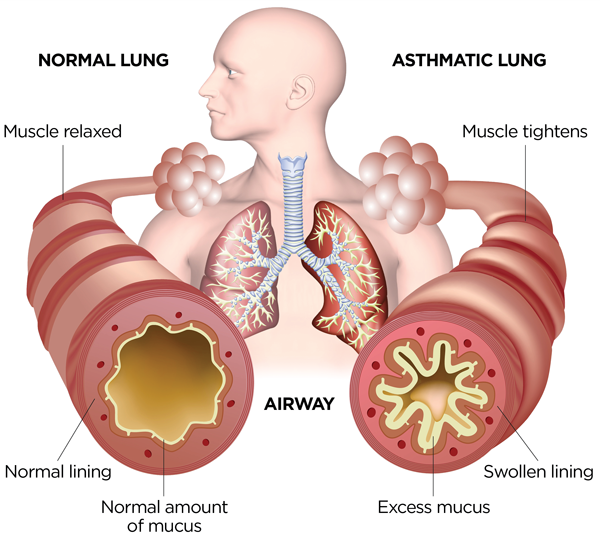A community health nurse is conducting an educational program on various environmental pollutants. The nurse should emphasize that clients who have which of the following disorders are especially vulnerable to ozone effects?
Mitral valve disease
Asthma
Nasal polyps
Seasonal allergies
The Correct Answer is B
Choice A reason: Mitral valve disease is not a disorder that makes clients especially vulnerable to ozone effects, as it does not affect the respiratory system. Mitral valve disease is a condition that affects the mitral valve, which is the valve that separates the left atrium and the left ventricle of the heart. Mitral valve disease can cause the valve to become narrow (stenosis) or leaky (regurgitation), affecting the blood flow and oxygen delivery to the body. Mitral valve disease can cause symptoms such as shortness of breath, fatigue, chest pain, palpitations, and swelling of the legs.
Choice B reason: Asthma is a disorder that makes clients especially vulnerable to ozone effects, as it affects the respiratory system. Asthma is a chronic inflammatory condition that causes the airways to become narrow, swollen, and sensitive to triggers such as allergens, irritants, infections, or exercise. Asthma can cause symptoms such as wheezing, coughing, chest tightness, and difficulty breathing. Ozone is a gas that is formed when sunlight reacts with pollutants in the air. Ozone can irritate the lungs and worsen asthma symptoms by causing inflammation, bronchoconstriction, and mucus production. Ozone can also reduce lung function and increase the risk of respiratory infections.
Choice C reason: Nasal polyps are not a disorder that makes clients especially vulnerable to ozone effects, as they do not affect the respiratory system. Nasal polyps are benign growths that form in the lining of the nose or sinuses. Nasal polyps can cause symptoms such as nasal congestion, runny nose, postnasal drip, loss of smell or taste, headache, and snoring. Nasal polyps are usually associated with chronic inflammation or allergies, but their exact cause is unknown.
Choice D reason: Seasonal allergies are not a disorder that makes clients especially vulnerable to ozone effects, as they do not affect the respiratory system. Seasonal allergies are allergic reactions that occur during certain times of the year when pollen or mold spores are high in the air. Seasonal allergies can cause symptoms such as sneezing, itching, watery eyes, runny nose, and sore throat. Seasonal allergies are caused by an overreaction of the immune system to harmless substances in the environment.

Nursing Test Bank
Naxlex Comprehensive Predictor Exams
Related Questions
Correct Answer is C
Explanation
Choice A reason: Repeat dose in 1 hour for unrelieved headache. This instruction is incorrect because sumatriptan should not be taken more than twice in 24 hours. Taking too much sumatriptan can cause serious side effects, such as high blood pressure, stroke, or heart problems.
Choice B reason: Chew the tablet well before swallowing. This instruction is incorrect because sumatriptan tablets should be swallowed whole with water. Chewing the tablet may affect its absorption and effectiveness.
Choice C reason: If you experience chest pain, call your physician immediately. This instruction is correct because chest pain is a serious and potentially life-threatening side effect of sumatriptan. Chest pain may indicate a heart attack or coronary artery spasm, which require immediate medical attention.
Choice D reason: Take daily to prevent headaches. This instruction is incorrect because sumatriptan is not a preventive medication for migraines. It is only used to treat acute migraine attacks when they occur. Taking sumatriptan daily can cause rebound headaches, which are worse and more frequent than the original ones.

Correct Answer is ["B","D","E"]
Explanation
Choice A reason: Initiating a plan of care for a client who is postoperative from an appendectomy is not a task that the RN should delegate to the LPN, as it requires nursing judgment, critical thinking, and assessment skills that are beyond the scope of practice of the LPN. The RN is responsible for developing, implementing, and evaluating the plan of care for each client based on their individual needs, preferences, and goals. The RN can delegate some aspects of the plan of care to the LPN, such as performing routine tasks or monitoring the client's status, but the RN must supervise and evaluate the LPN's performance.
Choice B reason: Administering a tap-water enema to a client who is preoperative is a task that the RN can delegate to the LPN, as it is a standardized procedure that does not require nursing judgment or assessment. The LPN has the knowledge and skills to perform this task safely and effectively, following the established policies and protocols of the facility. The RN should provide clear instructions and expectations to the LPN, such as the type, amount, and temperature of the solution, the position and comfort of the client, and the signs and symptoms to report. The RN should also verify that the LPN has completed the task and documented the outcome.
Choice C reason: Providing discharge instructions to a confused client's spouse is not a task that the RN should delegate to the LPN, as it involves teaching, counseling, and evaluating the client's and family's understanding and readiness for discharge. These are complex activities that require nursing judgment, communication skills, and evaluation skills that are beyond the scope of practice of the LPN. The RN is responsible for ensuring that the client and family receive adequate information and education about the client's condition, treatment, medications, follow-up care, and community resources. The RN can delegate some aspects of discharge planning to the LPN, such as collecting data or providing reinforcement of teaching, but the RN must supervise and evaluate the LPN's performance.
Choice D reason: Catheterizing a client who has not voided in 8 hours is a task that the RN can delegate to the LPN, as it is a standardized procedure that does not require nursing judgment or assessment. The LPN has the knowledge and skills to perform this task safely and effectively, following the established policies and protocols of the facility. The RN should provide clear instructions and expectations to the LPN, such as the type and size of the catheter, the sterile technique, and the urine output measurement. The RN should also verify that the LPN has completed the task and documented the outcome.
Choice E reason: Obtaining vital signs from a client who is 6 hours postoperative is a task that the RN can delegate to the LPN, as it is a routine task that does not require nursing judgment or assessment. The LPN has the knowledge and skills to perform this task safely and effectively, using appropriate equipment and techniques. The RN should provide clear instructions and expectations to the LPN, such as the frequency and parameters of vital signs monitoring. The RN should also verify that the LPN has completed the task and documented the outcome.
Whether you are a student looking to ace your exams or a practicing nurse seeking to enhance your expertise , our nursing education contents will empower you with the confidence and competence to make a difference in the lives of patients and become a respected leader in the healthcare field.
Visit Naxlex, invest in your future and unlock endless possibilities with our unparalleled nursing education contents today
Report Wrong Answer on the Current Question
Do you disagree with the answer? If yes, what is your expected answer? Explain.
Kindly be descriptive with the issue you are facing.
